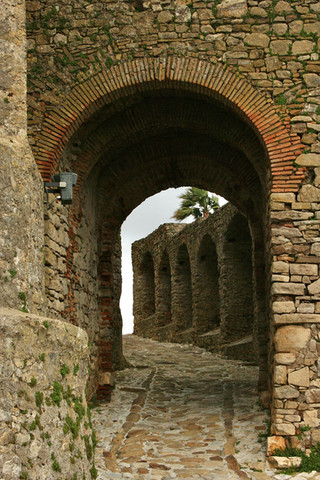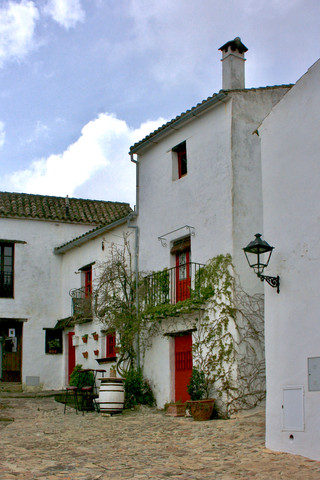Uphill Rambling on a Rocky Roman Road on a blustery spring day with our Kiwi amigos
- Fiona
- Apr 2, 2021
- 5 min read
Updated: Apr 7, 2021
Castellar de la Frontera is in the Sierra de Cadiz and the Los Alcornocales Natural Park. It is a village within the walls of a well preserved Moorish-Christian fortress and it is located on the top of a rocky precipice and has spectacular views. The information boards state that on a clear day you can see the entire bay of Algeciras, the silhouette of the Rock of Gibraltar and even the coast of Africa from the castle. One way to reach the castle is via a 1.7 kilometre uphill stretch of an ancient Roman road.
aerial view from los pueblos mas bonitos de espana to show the town within the castle walls
This extensive view from the castle site meant that it was a great location to look out for enemies and it is therefore unsurprising that it has been a highly sought after piece of real estate that has been populated continuously since prehistoric times.
Several groups that have occupied the site over the centuries include the Romans who were in the area from the second century BC. … evidence of this are the remains of a Roman road going up to the castle. It is believed that they built the road to connect the old city of Córdoba with the port city of Carteia (which is now known as Guadarranque, in San Roque and that a settlement on the hilltop was built to house people who would monitor and control the road.
After the fall of the Roman Empire (fifth century), the area on the Strait of Gibraltar was conquered by Vandal tribes and then by the Visigoths who occupied the site. In the eighth century the Arab-Moors arrived and in the fourteenth century they built the castle (and village within its walls) that remains to this day. They built the castle on top of the Roman ruins and as a fortress against the threat from the northern Spanish empires, especially Castile. After a few skirmishes between the Moors and the Spanish, the Spanish took over the castle when they finally conquered the Moors in the fifteenth century.
We could have driven right up to the castle on a smoothly paved road but the idea of walking on the ancient rocky Roman road was too good to pass up and so we began our ascent accompanied by Alan and Martin coming up with many quotes about Romans from the film 'The Life of Brian' "… …what have the Romans ever done for us…etc" as well as all of us speculating about how many Romans (or their slaves) it took to build the road, where they got the rocks/cobbles from, how their chariots negotiated the cobbles etc!
Another point of interest about the Roman road is that it is part of the GR7 the Gran Recorrido (Long Journey) which is a route designed to avoid crossing or using tarmac roads or any roads used by traffic, wherever possible. It is based on an ancient trade route beginning at Tarifa, in the Straits of Gibraltar and crosses the coastal mountains of Spain, the Pyrenees, France, Switzerland, Austria, Hungary, Rumania and Greece and is about 10,500 kilometres long!
As we walked, we admired the surrounding countryside including the hills that were wearing their spring, vibrant-green, forest coat that was speckled with many small aromatic flowers including yellow broom/gorse, rock roses and lavender. We were also able to see many cork oak trees in the forest and in fact, the name of the park "Los Alcornocales" means "the cork oak groves”. There are many retail outlets in Andalusia which sell souvenirs made from cork and they are made from cork that is harvested in local forests such as the Los Alcornocales.
Having never seen cork trees before, I was interested to see how they differ from other trees. we learnt that directly under the bark is the spongy layer of cork and then under that is a tree's living layer. When the cork is harvested, the bark is peeled off and the cork layer removed. Apparently harvesting cork from a given tree can be undertaken every ten to twelve years without damaging the tree.
We eventually made it to the top of the hill, where we paused to admire the surrounding countryside - including where the Guadarranque River flowed into a reservoir (which looks like a lake) and the rather grand castle whose walls seemed colossal and impenetrable making it hard for us to comprehend how the Spanish managed to breach the castle walls and defeat the Moors way back in the fifteenth century.
After a short time of being buffeted by a Wellington-strength wind, we sought shelter within the castle walls - entering via a walled, zigzag path that guided us through an impressive arched gateway (which must have also been difficult to penetrate) and then into a courtyard with the requisite Andalusian orange tree at its centre.
We looked back and up to admire the scale of the fortress walls and then turned to appreciate the pretty courtyard scene of white washed buildings (although they were in need of a wash) with red trim on the windows and door frames of some of the buildings.
A narrow street leading off the courtyard beckoned us - and we went on to discover the town within the castle - a town of white washed houses on cobbled streets - a town that has the status of “one of the most beautiful towns in Spain” (The Most Beautiful Towns of Spain is a Spanish association created in 2011 with the aim of promoting, disseminating, fostering and preserving the cultural, natural and rural heritage in geographical areas with a lower level of industrialisation and population.)
As well as having this 'Beautiful Town' distinction, the recent history of Castellar is quite intriguing - in 1971, the original inhabitants of the castle town were relocated 7 kilometres away to the new town of Nuevo (New) Castellar. Some of the dilapidated houses at the original castle then became homes for hippies mostly from Germany, (apparently some still live there even now). Then in 1983 the Spanish Government expropriated the castle and declared it a ‘Historical and Artistic Monument’ and invested in its restoration. Today there is a hotel within the fortress walls, as well as many houses that have been restored and transformed into restaurants and accommodation.
And then it was time to leave...
We descended via the road this time as I wanted to see some of the houses that were outside the castle walls. There was an interesting mix of new builds, roadside cafes (where we stopped for a coffee) and abandoned ramshackle dwellings which prompted us to discuss whether they might be contenders for the 1 euro rural village regeneration projects that are currently occurring throughout Spain and Italy!










































































Comments